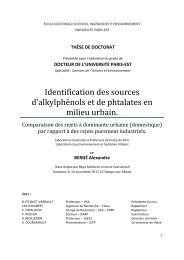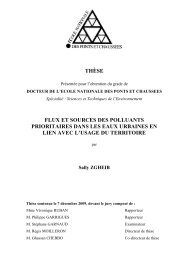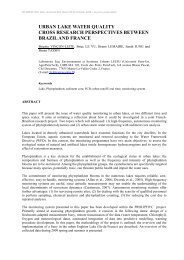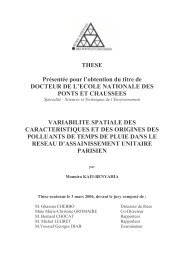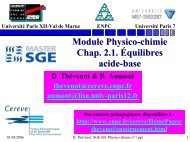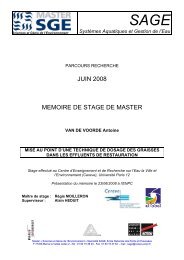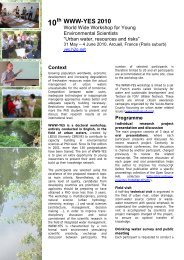View - ResearchGate
View - ResearchGate
View - ResearchGate
You also want an ePaper? Increase the reach of your titles
YUMPU automatically turns print PDFs into web optimized ePapers that Google loves.
Figure 5: Cluster analysis of microbial biofilms formed in MFC reactors using different wastewaters.Clustering analysis was done on DGGE fingerprints obtained by the bacteria present in the MFC biofilms (Bio),and initial inoculums (Inoc) for the different wastewaters (WW).Cyclic Voltammetry was used to determine the electrochemical activity of bacteria developedin the different MFC reactors. This technique is able to identify the presence of electron shuttlecompounds, which could be naturally produced by bacteria to increase the rate of electrontransfer (Rabaey et al., 2005, Von-Canstein et al., 2008). The electron shuttle compounds socalled “mediators” are stable molecular weight molecules that have the ability to becontinuously reduced and oxidized (Lens et al., 2005). They accept electrons (reduction) fromthe bacterium cell, transport those electrons to the electrode surface where they drain them off(oxidation) and start the cycle again (Ieropoulos et al., 2005). Paper wastewater presented anoxidation and reduction peak with an overall red-ox potential of -0.325 V vs Ag/AgCl (-0.13 Vvs NHE) (Figure 6) while the other MFC cells did not present red-ox activity. As can be seenin Figure 6, the oxidation peak is higher than the reduction peak which implies that theoxidation reaction was more favoured than the reduction reaction. These results providedstrong evidence that bacteria developed in MFC reactors using paper wastewater produced anelectron shuttle compound that increased the rate of bacterial electron transfer to the anode andexplains why current outputs from the MFC reactors using paper wastewater were higher thanfor other MFCs.The present study determined how wastewater characteristics affect current output in MFC. AllMFC systems achieved high COD removal rates although only MFC fed with paperwastewaters developed a high current output. MFC microbial biofilm communities differedaccording to the wastewater type. Bacteria specifically developed in MFCs using paperwastewater were electrochemically active and were able to produce an electron shuttlecompound. The mediator producing bacteria were found to be able to use different types ofwastewaters to shuttle electrons. These findings enhance our understanding of the interactionstaking place in the microbial fuel cell anode. Further work will be conducted to establish thetype of electron shuttle compound produced and the microbial electroactive communitiesresponsible for the enhancement of the current output.ACKNOWLEDGEMENTSSharon Velasquez gratefully acknowledges CONACyT, Mexico for supporting her doctoralstudies via grant 196298 and appreciates the support of the companies that allowed samplingtheir effluents and Northumbria Water for the anaerobic sludge.REFERENCES21.5Eo = -0.325 V vs Ag/AgCl= -0.126 V vs NHEOxidation peakAiyuk, S., Forrez, I., Lieven, D. K., van Haandel, A. and Verstraete, W. (2006). Anaerobicand complementary treatment of domestic sewage in regions with hot climates-A review.Bioresource Technology, 97(17), 2225-2241.Current / mA10.5Potential (Ag/AgCl) / mV0-500 -450 -400 -350 -300 -250 -200 -150 -100 -50 0Cheng, S. and Logan, B. E. (2007). Ammonia treatment of carbon cloth anodes to enhancepower generation of microbial fuel cells. Electrochemistry Communications, 9(3), 492-496.Curtis, T.P. and Craine, N.G. (1998) The comparison of the bacterial diversity of activatedsludge plants. Water Science and Technology 37, 71-78.-0.5-1Reduction peakDavis, F. and Higson, S. P. J. (2007) Biofuel cells-Recent advances and applications,Biosensors and Bioelectronics, 22, (7), 1224-1235.Figure6: Cyclic voltammetry of MFC operated using paper wastewater. Scan rate 10 mV/s, W = 0, 3rd cycleat room temperature.Finally to evaluate the ability to use bacterial communities present in paper wastewater forother substrates. MFC reactors operated using other substrates where conditioned for one batchwith paper wastewater and 50 mM of phosphate buffer. After this conditioning period, for allsubsequent batches, MFCs using dairy and brewery wastewaters increased their current outputto values between 0.25 and 0.30 mA (only previously obtained by MFCs using paperwastewater and 50mM phosphate buffer) (Figure 4, c). This indicated that the electroactivecommunities were able to be transferred to MFCs operating in other anodic conditions andincrease the current outputs using other types of wastewaters. However MFCs using bakerywastewater did not increased the current output. Presumably microbial communities present inthis reactor inhibited the development of electrochemical bacteria.CONCLUSIONSDu, Z., Li, H. and Gu, T. (2007). A state of the art review on microbial fuel cells: Apromising technology for wastewater treatment and bioenergy. Biotechnology Advances,25(5), 464-482.Hipolito, C. N., Crabbe, E., Badillo, C. M., Zarrabal, O. C., Morales Mora, M. A., Flores, G.P., Hernández Cortazar, M. d. A. and Ishizaki, A. (2008). Bioconversion of industrialwastewater from palm oil processing to butanol by Clostridium saccharoperbutylacetonicumN1-4 (ATCC 13564). Journal of Cleaner Production, 16(5), 632-638.Ieropoulos, I. A., Greenman, J., Melhuish, C. and Hart, J. (2005). Comparative study of threetypes of microbial fuel cell. Enzyme and Microbial Technology, 37(2), 238-245.Lastella, G., Testa, C., Cornacchia, G., Notornicola, M., Voltasio, F. and Sharma, V. K.(2002). Anaerobic digestion of semi-solid organic waste: biogas production and itspurification. Energy Conversion and Management, 43(1), 63-75.WWW-YES 2008, Paris 13 – 16 May 2008 145WWW-YES 2008, Paris 13 – 16 May 2008 146



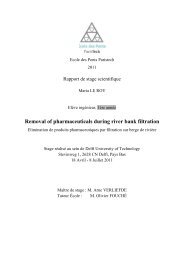
![[pastel-00730831, v1] Incidence des pratiques d'entretien ... - LEESU](https://img.yumpu.com/50938896/1/184x260/pastel-00730831-v1-incidence-des-pratiques-dentretien-leesu.jpg?quality=85)

